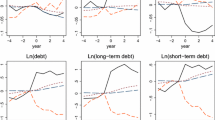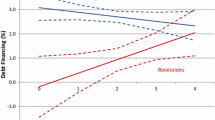Abstract
The main purpose of this study is to examine the determinants of the corporate choice between different forms of debt financing. By analyzing the most comprehensive sample of US corporate debt issues to date, I find that firms that issue 144A debt have significantly lower credit quality and higher information asymmetry than firms that issue traditional non-bank private debt. Further, the study shows that traditional private placements, rather than bank loans, are the favorite private debt source for firms with good credit quality. I also show that the firm characteristics of traditional private debt issuers have significantly changed after 1990 through to 2003. My results suggest the following pecking order of debt choices which is conditional on credit quality. In other words, high credit quality firms prefer public bond offerings and small firms, with good credit quality, are more likely to issue traditional private debt. A large group of firms characterized by moderate credit quality make extensive use of bank loans and poor credit quality firms preferentially issue 144A debt.
Similar content being viewed by others
Notes
Results presented in previous studies confirm the predominance of debt over equity as source of capital for US firms. For instance, Bhojraj and Sengupta (2003) report that the aggregate value of public debt issues in US was $651 billion in 1996 and $1 trillion in 1998 while the value of new equity issues was $122 billion in 1996 and $126 billion in 1998.
This study refers to Rule 506 and regulation D private placements as traditional private placements. I report a description of non-bank private debt characteristics in Sect. 2.1.
Accredited investors are investors with net worth of at least $2,500,000 or income of at least $250,000. Sophisticated investors are investors whom a company reasonably believes have adequate knowledge and experience in financial and business matters to evaluate the securities offered for sale.
The holding period was 2 years until February 1997.
The following institutions qualify as QIBs. Institutions such as insurance firms or pension plans that own or invest at least $100 million in securities of nonaffiliates; banks or savings and loan (S&L) associations that have audited net worth of at least $25 million; brokers or dealers registered under the Exchange Act, acting for their own account or for that of QIBs that own and invest at least $10 million in securities of nonaffiliates; and entities whose equity holders are all QIBs.
Event studies and long-term performance studies following debt placements provide complementary evidence to debt choice studies. Dichev and Piotroski (1999) report non-significant long-term returns following public straight debt issues but positive long-term returns following private debt issues. Chandra and Nayar (2008) further investigate this issue and find positive returns at the time of the announcement of private debt, but a negative long-term performance following issuance of private debt. Chang et al. (2007) show that low-quality firms can improve debt announcement returns by issuing secured debt.
The majority of loans in the sample of this study consists of syndicated loans.
The main results of this study do not change if debt is aggregated by year or by month.
The sample of this study is also about 12% larger than the Gomes and Phillips (2007) debt sample. The difference in size would be even larger if in this study debt were aggregated within 1 month as in Gomes and Phillips (2007) instead of 3 months. Eckbo et al. (2007) report descriptive statistics on a longitudinally larger sample.
This sample starts in 1981 because SDC starts full coverage of US traditional private placements in that year.
For the t tests and multivariate analysis I use the natural logarithm of firm size, issue size, and firm age.
Bank loans were not rated before 1995. As indicated by Yi and Mullineaux (2006), in 1995 rating agencies started rating syndicated loans.
Butera and Faff (2006) provide an overview on how banks use firm characteristics to estimate credit ratings.
When I estimate Ivol using the market model my results do not significantly change.
Altman’s Z is another variable that is potentially correlated to other financial accounting variables used in the regression. However, the variance inflation factor (VIF) of Altman’s Z is less than 2, revealing that there is no multicollinearity between Altman’s Z and the other independent variables.
The result of Hausman test suggests that the firm and year effects are uncorrelated with the independent variables, confirming that random effects is the appropriate approach.
The first-step of this analysis is an OLS regression instead of an ordinal logit because logit regressions do not provide residuals. It is important to notice that when an ordered logit is estimated instead of an OLS regression, the magnitude, sign, and significance of the coefficients are very similar to those presented in panel A of Table 6.
As shown in Table 2, only 46% of the firms that issue traditional private placements are rated by either Moody’s or S&P. The lack of significance of the difference in credit rating between private issuers and 144A issuers might be caused by the absence of credit ratings for many companies that issue traditional private placements. However, missing ratings do not decrease the sample size. I avoid dropping observations with missing ratings by setting the missing ratings to zero and introducing an indicator variable (Missing_rating) that is set to unity for the missing observations (a similar approach for missing data is used by Fama and French (2002) and Palia (2001)).
These regressions are available upon request from the author.
References
Altman E (1977) The Z-score Bankruptcy model: past, present, and future. Wiley, New York
Angbazo LA, Mei J, Saunders A (1998) Credit spreads in the market for highly leveraged transaction loans. J Bank Financ 22:1249–1282
Arena MP, Howe JS (2009) Takeover exposure, agency, and the choice between private and public debt. J Financ Res 32:199–230
Berger AN, Udell GF (1998) The economics of small business finance: the roles of private equity and debt markets in the financial growth cycle. J Bank Financ 22:613–673
Bhojraj S, Sengupta P (2003) Effect of corporate governance on bond ratings and yields: the role of institutional investors and outside directors. J Bus 76:455–475
Blackwell DW, Kidwell DS (1988) An investigation of cost differences between public sales and private placements of debt. J Financ Econ 22:253–278
Butera G, Faff R (2006) An integrated multi-model credit rating system for private firms. Rev Quant Financ Account 27:311–340
Cantillo M, Wright J (2000) How do firms choose their lenders? Rev Financ Stud 13:155–189
Carey MS, Prowse SD, Rea JD, Udell GF (1993) The economics of the private placement market. Financ Mark Inst Instrum 2:1–66
Chandra U, Nayar NN (2008) The information content of private debt placements. J Bus Financ Account 35:1164–1195
Chang S-C, Chen S-S, Hsing A, Huang CW (2007) Investment opportunities, free cash flow, and stock valuation effects of secured debt offerings. Rev Quant Financ Account 28:123–145
Chaplinsky S, Ramchand L (2004) The impact of SEC rule 144A on corporate debt issuance by international firms. J Bus 77:1073–1097
Chen L, Zhao S (2006) On the relation between the market-to-book ratio, growth opportunity, and leverage ratio. Financ Res Lett 3:253–266
Denis DJ, Mihov VT (2003) The choice among bank debt, non-bank private debt and public debt: evidence from new corporate borrowings. J Financ Econ 70:3–28
Diamond DW (1984) Financial intermediation and delegated monitoring. Rev Econ Stud 51:393–414
Diamond DW (1991) Monitoring and reputation: the choice between bank loans and directly placed debt. J Polit Econ 99:689–721
Dichev ID, Piotroski JD (1999) The performance of long-run stock returns following issues of public and private debt. J Bus Financ Account 26:1103–1132
Eckbo BE, Masulis RW, Norli Ø (2007) Security offerings. In: Eckbo BE (ed) Handbook of corporate finance. Elsevier
Fairchild LM, Flaherty SM, Shin YS (2009) Analysis of unsolicited credit ratings in Japan: new evidence from Moody’s. Rev Pac Basin Financ Mark Polic 1:103–123
Fama EF (1985) What’s different about banks. J Monet Econ 15:29–39
Fama EF, French KR (1993) Common risk factors in the returns on stocks and bonds. J Financ Econ 33:3–56
Fama EF, French KR (2002) Testing trade-off and pecking order predictions about dividends and debt. Rev Financ Stud 15:1–33
Faulkender M, Petersen MA (2006) Does the source of capital affect capital structure? Rev Financ Stud 19:45–79
Fenn GW (2000) Speed of issuance and the adequacy of disclosure in the 144A high-yield debt market. J Financ Econ 56:383–405
Gomes A, Phillips G (2007) Why do public firms issue private and public securities? Working Paper
Hadlock CJ, James CM (2002) Do banks provide financial slack? J Financ 57:1383–1419
Henderson BJ, Jegadeesh N, Weisbach MS (2006) World markets for raising new capital. J Financ Econ 82:63–101
Jensen MC (1986) Agency costs of free cash flow, corporate finance, and takeovers. Am Econ Rev 76:323–329
Johnson CJ (1991) Corporate finance and the securities law. Prentice-Hall Law & Business Press, Englewood Cliffs
Johnson SA (1997) An empirical analysis of the determinants of corporate debt ownership structure. J Financ Quant Anal 32:47–69
Kaplan RS, Urwitz G (1979) Statistical models of bond ratings: a methodological inquiry. J Bus 52:231–262
Klock M, Mansi S, Maxwell W (2005) Does corporate governance matter to bondholders? J Financ Quant Anal 40:693–719
Krishnaswami S, Spindt PA, Subramaniam V (1999) Information asymmetry, monitoring, and the placement structure of corporate debt. J Financ Econ 51:407–434
Leland HE, Pyle DH (1977) Informational asymmetries, financial structure, and financial intermediation. J Financ 32:371–387
Myers SC (1977) Determinants of corporate borrowing. J Financ Econ 5:147–175
Palia D (2001) The endogeneity of managerial compensation in firm valuation: a solution. Rev Financ Stud 14:735–764
Smith CW, Watts R (1992) The investment opportunity set and corporate financing dividend and compensation policies. J Financ Econ 32:263–292
Yi H-C, Mullineaux DJ (2006) The informational content of bank loan ratings. J Financ Res 29:481–501
Yosha O (1995) Information disclosure costs and the choice of financing source. J Financ Intermed 4:3–20
Ziebart DA, Reiter SA (1992) Bonds ratings, bond yields and financial information. Contemp Account Res 9:252–282
Acknowledgments
I would like to thank the editor (Cheng-Few Lee), two anonymous referees, Paul Brockman, Stephen Ferris, John Howe, Brandon Julio, Mahendrarajah Nimalendran, Sarah Peck, Emre Unlu, Christopher Wikle, and seminar participants at University of Missouri and Marquette University for helpful comments and suggestions.
Author information
Authors and Affiliations
Corresponding author
Rights and permissions
About this article
Cite this article
Arena, M.P. The corporate choice between public debt, bank loans, traditional private debt placements, and 144A debt issues. Rev Quant Finan Acc 36, 391–416 (2011). https://doi.org/10.1007/s11156-010-0182-3
Published:
Issue Date:
DOI: https://doi.org/10.1007/s11156-010-0182-3




